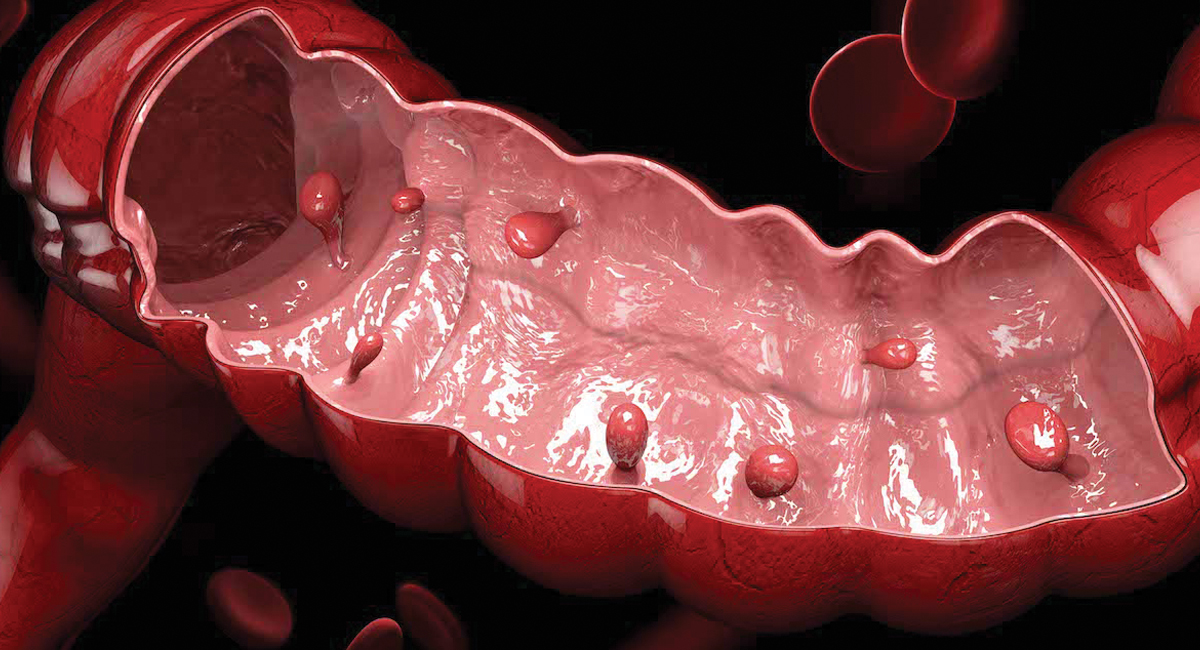
Introduction
The colon or the large intestine is a part of the digestive system. The large intestine is a hollow tube and is the last bit in the digestive system. It is here that the body forms and stores the stool. Colon polyps are overgrowth in the large intestine. It is also called colorectal polyps. Often, these polyps are harmless and diagnosed only during tests conducted to determine colon cancer (polyps, in a few cases, progress to cancer).
Description
A colon polyp is a small clump of cells formed in the lining of the large intestine. There are two types of colon polyps: neoplastic and non-neoplastic. Non-neoplastic polyps include hyperplastic polyp, inflammatory polyp, and hamartomatous polyps. The non-neoplastic variety does not become cancerous, but the neoplastic type has adenomas and serrated polyps. The bigger the polyp, the higher the risk of cancer.
Regular screening tests such as colonoscopy show polyps. If they are diagnosed early, they can be removed safely and completely.
Request an Appointment at Smiles
What are the Causes of Colon Polyps?
As mentioned, colon polyps are of two types: neoplastic and non-neoplastic. Inflammatory polyps are seen in case of ulcerative colitis or Crohn’s disease. Polyps themselves are not a threat, but Crohn’s disease increases the overall risk of colon cancer.
What are the Risk factors of Colon Polyps?
- ● Age : People above the age of 50 are at risk.
- ● Inflammatory conditions such as ulcerative colitis or Crohn’s disease: These factors result in a predisposition to developing colon polyps and, maybe, colon cancer at a later stage.
- ● Family history : If a person has a genetic predisposition (if someone in the family has had this condition before), they are at a higher risk.
- ● Tobacco and alcohol abuse.
- ● Obesity and lack of exercise.
- ● Race: African-Americans are at a greater risk..
- ● Uncontrolled type 2 diabetes.
- ● Certain hereditary disorders can also cause colon polyp such as :
- Lynch syndrome : It is also called non-polyposis colorectal cancer, which tends to develop a few colon polyps, and the chances of these turning malignant are high. It is also associated with tumours of the stomach, intestine, urinary tract, and ovaries.
- Familial adenomatous polyposis : A rare genetic disorder where the patient develops a few hundred to thousands of polyps along the intestinal lining. If this condition is not treated promptly, it progresses to cancer.
- Gardner syndrome : Along with polyps, the patient also develops tumours in the skin, abdomen, and bones.
- Mutation in MYH genes : This causes adenomatous polyps and colon cancer at a young age.
- Peutz-Jeghers syndrome : Freckles are seen all over the body including, lips, gums, and feet. It also causes the growth of non-cancerous polyps that can later become cancerous.
- Serrated polyposis syndrome : This causes multiple serrated polyps.
What are the Symptoms of Colon Polyps?
- ● Rectal bleeding.
- ● Blood in stools : Stools may appear reddish or black.
- ● Constipation or diarrhea : Constipation or diarrhea that lasts for more than a week.
- ● Pain : Due to obstruction in the intestine, there may be cramps in the abdomen.
- ● Iron deficiency anemia : Due to polyps, there may be chronic bleeding without a change in stool color. In the long run, this can cause iron deficiency anemia, and the patient may feel breathless and tired.
How are They Diagnosed ?
- ● Colonoscopy : A thin, flexible tube is passed through the anus with a camera attached at the tip allowing the doctor to study the rectum and colon. If a polyp is present, the doctor immediately excises and sends it for analysis.
- ● Sigmoidoscopy : It is similar to colonoscopy, but the tissue cannot be removed for further analysis as seen in colonoscopy.
- ● CT colonography : It is also called virtual colonoscopy, where a CT scan gets the doctor 2D and 3D images of the colon.
- ● Barium enema : Liquid barium is injected through the rectum, and a special x-ray captures images of the colon. This makes the colon appear white and makes it easier to identify the polyp.
- ● A stool test : This is done to check if there is any microscopic bleeding.
How are They Treated?
What are the Risks Involved in Surgery?
- ● Perforation or rectal bleeding.
- ● Severe pain or bloating.
- ● Infection at the surgical site.
- ● Vomiting.
What are the Prevention Measures?
- ● A fiber-rich diet eases the movement of the food through the colon and can prevent the formation of polyps.
- ● Increase the intake of vitamin D and calcium.
- ● Reduce the intake of red meat, high-fat foods, and processed foods.
Request an Appointment at Smiles
FAQ's
Are Polyps Almost always PreCancerous?
How Long Does it take to Heal After Polypectomy?
Is it Necessary to Surgically Remove Polyps if they are Non-Symptomatic?
Can Polyps Recur After Removal?
Can Polyps Resolve Themselves?
Need Help?
For any Information about our Locations, Doctors or Treatments.
